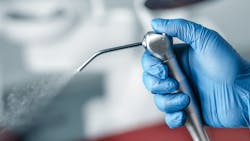Is your practice overlooking this important step in the infection control process?
One of the main goals behind any infection control procedure is to ensure the sterilization and maintenance of dental unit waterlines. It has been well established that good quality water run through the dental unit waterlines is essential, but it is even more vital to carry out testing, shocking, and treatment of the waterlines to clean any biofilm buildup. Biofilm in the lines can make the process less safe for patients, and unclean instruments could contribute to contamination and the spread of infection.
Dental offices are testing and shocking the dental unit waterlines, but our concern for patient safety doesn’t stop there. Cleanliness of air/water syringes should be a priority to prevent cross-contamination or an infection control breach. These tools are simple, and because of this, they’re often neglected and forgotten. The consequences of this small, often-overlooked detail could be disastrous for a dental practice. Disposable tips are a good alternative to the reusable tips that require sterilization.1
Metal syringe tips require maintenance
Proper sterilization of metal air/water tips involves more than just tossing a tip into a bag and placing it in the autoclave. Clinicians must consider the inside of the metal air/water syringe, and this takes extra work to clean. Research has also shown that there is a significant amount of bacterial growth in nondisposable syringe tips, and that sterilization practices are not effective regardless of how many times the tool is used, rinsed, or cleaned.2 It is not always possible to clean reusable tips fully before sterilization, leading to biofilm growth that can impede future sterilization by preventing steam from reaching the areas that need it most.3
A dental office’s infection control coordinator needs to review the manufacturer’s instructions for proper sterilization, then create standard operating procedures and infection control protocols for the team to follow. Dental teams will need to know precisely how to clean and sterilize the tips to ensure the complete removal of any biofilm left inside. If proper sterilization cannot occur, that tool is useless for subsequent patients when adhering to appropriate infection control protocols.
Cost is a factor
Saving money is a key factor in the operation of most dental practices. After all, why pay more for something when you can get by with an alternative for less? However, while cutting corners may save a few dollars, it can put patient safety at risk.
When choosing between reusable and disposable tips, many may see the upfront costs as the whole picture when there are many other factors to consider. Additional factors—such as the time it takes to properly clean and sterilize metal syringe tips—are often not considered. Dental professionals could spend this time doing the many, many other tasks needed to keep a dental practice running. This inefficient use of time could very well add up to much more than the cost of safer disposable tips.
Nondisposable metal syringe tips may be more cost-effective than the disposable alternative on the front end, but being unable to adequately preclean and sterilize tips can have costly ramifications in the long run. The impact of using a tool that may not be adequately sterilized could far outweigh the initial cost of buying disposable. The risk of cross-contamination and infection in patients could result in untold cost to the practice if it does occur.
Single-use syringe tips provide a distinct advantage by eliminating the risk of cross-contamination since they are used only once, on one patient, and then disposed of safely.4
Are disposable tips effective?
Some dental professionals may believe that disposable tips don’t offer stable water pressure or don’t separate air and water well enough. This is a huge concern when performing procedures that require an absolute dry field. Ensuring your air/water syringe achieves a tight fit and seal can help guarantee the separation of the air and water so that the procedure can go just as smoothly as it would with a metal syringe tip. If you have had issues with disposable tips, I encourage you to check out a few brands to find one that works for you.
Summary
Preference and cost savings can play a crucial role in the reluctance to switch to single-use syringe tips. With research stating that proper sterilization is not entirely possible, though, waiting for a cross-contamination or spending hours sterilizing a tool that will never become fully clean is counterproductive. Delivering clean water doesn’t start and end with waterlines. Dental teams need to take into account the tools the treated water will flow through before reaching the patient. Tools like the air/water syringe are easy to pop into place not thinking about the impact on patient safety. Discuss this topic as a practice and decide if disposable tips are the right solution for you.
REFERENCES
- Valeriani F, Protano C, Gianfranceschi G, et al. Infection control in healthcare settings: perspectives for mfDNA analysis in monitoring sanitation procedures. BMC Infect Dis. 2016;16:394. doi:10.1186/s12879-016-1714-9
- Inger M, Bennani V, Farella M, Bennani F, Cannon RD. Efficacy of air/water syringe tip sterilization. Aust Dent J. 2014;59(1):87-92. doi:10.1111/adj.12146
- Molinari JA, Nelson P. Reusable versus disposable air/water syringe tips. The Dental Advisor. June 2012. Accessed February 10, 2021. https://www.dentaladvisor.com/pdf-download/?pdf_url=images/pdfs/reusable-versus-disposable-air-water-syringe-tips.pdf
- FAQ – Instruments & Equipment – 2013. The Organization for Safety Asepsis and Prevention (OSAP). Accessed February 8, 2021. https://www.osap.org/page/FAQIE20139/FAQ---Instruments--Equipment---2013.htm
MICHELLE STRANGE, MSDH, RDH, brings over 20 years of experience to her numerous roles in dentistry. A graduate of the Medical University of South Carolina with a bachelor’s of health science and the University of Bridgeport with a master’s in dental hygiene education, she is focused on expanding the knowledge of her colleagues in all aspects of health care. Strange’s passion for dentistry and its connection to overall health extends to her community and global efforts. Currently, she is the cofounder and cohost of the longest-running podcast for dental hygienists, A Tale of Two Hygienists, the cofounder of Level Up Infection Prevention and TriviaDent, a practicing dental hygienist, and client success manager for MouthWatch.
About the Author
Michelle Strange, RDH
Michelle Strange, RDH, is a dedicated dental hygienist and educator passionate about infection control and patient safety. With over 20 years of experience in clinical practice, Michelle is committed to sharing evidence-based solutions to improve dental care outcomes.

